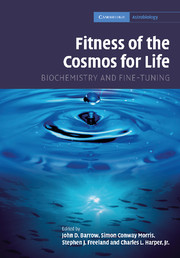Book contents
- Frontmatter
- Contents
- List of contributors
- Foreword: The improbability of life
- Preface
- Acknowledgments
- Part I The fitness of “fitness”: Henderson in context
- Part II The fitness of the cosmic environment
- 6 Fitness and the cosmic environment
- 7 The interconnections between cosmology and life
- 8 Chemistry and sensitivity
- 9 Fitness of the cosmos for the origin and evolution of life: from biochemical fine-tuning to the Anthropic Principle
- Part III The fitness of the terrestrial environment
- Part IV The fitness of the chemical environment
- Index
- References
8 - Chemistry and sensitivity
Published online by Cambridge University Press: 18 December 2009
- Frontmatter
- Contents
- List of contributors
- Foreword: The improbability of life
- Preface
- Acknowledgments
- Part I The fitness of “fitness”: Henderson in context
- Part II The fitness of the cosmic environment
- 6 Fitness and the cosmic environment
- 7 The interconnections between cosmology and life
- 8 Chemistry and sensitivity
- 9 Fitness of the cosmos for the origin and evolution of life: from biochemical fine-tuning to the Anthropic Principle
- Part III The fitness of the terrestrial environment
- Part IV The fitness of the chemical environment
- Index
- References
Summary
Introduction
In recent years, there has been great interest among some particle physicists and astronomers in assessing the dependence of the gross structure of the universe on the values of its defining constants of nature. This agenda has been partly motivated by the recognition that many of the most important structures in the universe, and its most crucial evolutionary pathways over billions of years of cosmic history, are surprisingly sensitive to the values of some of those constants. Since we lack any fundamental understanding of why any of the constants of nature take the values that they do, this state of affairs appears surprisingly fortuitous. It provokes cosmologists to consider our observed universe in the context of a wider ensemble of possible universes in which the laws of nature remain the same but the constants of nature, or the boundary conditions that specify the overall expansion dynamics of the universe, are allowed to change. In effect, a type of “stability” analysis is performed to ascertain how large such changes in the structure of the universe and its defining constants could be and still give rise to a recognizable universe.
These considerations have attracted renewed attention with the realization that our universe may have a significant non-uniform structure in space, in which the values of many of the quantities that we dub “constants” may in fact be variable values of spacetime-dependent fields.
- Type
- Chapter
- Information
- Fitness of the Cosmos for LifeBiochemistry and Fine-Tuning, pp. 132 - 150Publisher: Cambridge University PressPrint publication year: 2007
References
- 1
- Cited by



